Gallery FIT
March 7 – April 1, 2017
Share using #AdrianBeyond on Twitter and Instagram.
Gilbert Adrian (1903-1959) built his career as a costume designer at Metro-Goldwyn-Mayer,
where he worked on more than 250 films, including The Wizard of Oz. His creations for glamorous actresses such as Joan Crawford and Katharine Hepburn
inspired women of all ages. Macy’s and other retailers recognized this as a marketing
opportunity and opened small boutiques within department stores across the country
— “cinema shops,” featuring ensembles based on costumes seen in Hollywood films. To
promote them, MGM released a short film in 1940 entitled “Hollywood: Style Center
of the World.” Encouraged by the success of the cinema shops, Adrian opened a fashion
house in 1942 and began to create looks that appealed to his new leading lady: the
American woman.
This exhibition, Adrian: Hollywood and Beyond, highlighted both Adrian’s ready-to-wear and his costumes, while focusing on his
innovative use of textiles. Beginning during his Hollywood days, fabric was central
to Adrian’s aesthetic. He employed an arsenal of techniques — such as appliqué, piecing,
mitering, pleating, and draping — to build dynamic garments in which the materials
are as celebrated as they are integral to the design. Adrian worked with and endorsed
different textile manufacturers throughout his career. Indeed, his final collection
in 1952 was dedicated to the “beauty” and “integrity of fabric.”
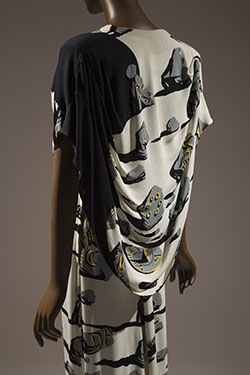
Adrian, evening dress, 1947, USA, textile by Salvador Dalí/Wesley Simpson, Gift of
Lola Walker, P90.69.1
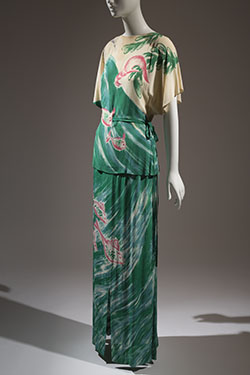
Adrian, two-piece evening ensemble, circa 1944, USA, Gift of Lola Walker, 70.40.2
Wesley Simpson, a New York textile converter who transformed the illustrations of
artists such as Marcel Vertes and Ludwig Bemelmans into pattern repeats, provided
Adrian with exciting rayons to animate his designs. Also during Adrian’s career, the
textile industry embraced growing public interest in the fine arts — a connection
that becomes clear when considering his rayon evening gown made from a Wesley Simpson
print, based on an illustration by Surrealist artist Salvador Dalí (himself a frequent
contributor to the fashion and textile worlds). Adrian recognized the value of this
spectacular textile and composed a gown that is a harmonious union of print and fashion
design. Using drapery and appliqué, he extended Dalí’s shadowy boulder motif into
a dark capelet.
Adrian frequently used organzas, taffetas, and mousselines from Bianchini-Férier,
a French silk mill that has produced fabric for couturiers since the nineteenth century.
Although Adrian preferred to use rayon crepes to achieve his slim silhouette in the
early 1940s, later in his career he turned to the lightness of Bianchini silks to
create voluminous eveningwear. Adrian made Bianchini fabrics the focal point of his
fall 1949 collection. Inspired by Africa, he chose textiles that ranged from a lamé
snakeskin to a warp-printed silk tiger stripe.
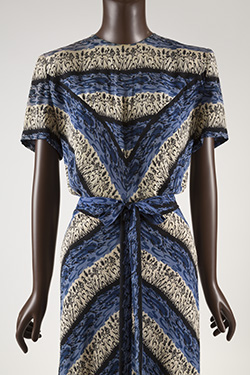
Adrian, day dress, 1943, USA, printed rayon, 70.40.8
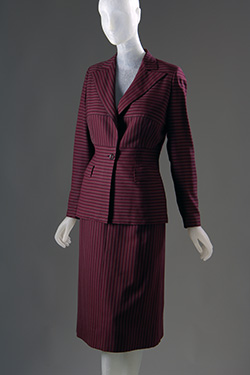
Adrian suit, 1945, USA, woolen textile by Pola Stout, 66.110.1
Adrian collaborated with woven textile designer Pola Stout throughout the 1940s.
She sent striped and checkered wools to Adrian, who sketched garments inspired by
her work and then returned the samples to be rewoven to his specifications. In Adrian’s
hands, a restrained suiting fabric could become a bold and unique garment, often by
means of mitering, the cutting and piecing together of fabric at an angle. Adrian’s
collaborations with Stout resulted in some of his most celebrated suits, described
by Vogue as “never melodramatic, never dull.” Designers who were trying to meet wartime
fabric restrictions adopted the distinctive triangular silhouette — square, padded
shoulders narrowing into a slim-hipped skirt — that Adrian had already perfected.
While best remembered for his tailored daytime looks, Adrian was also a skillful and
inventive draper. He used this technique in both his film and fashion work to create
glamorous evening gowns. In a stunning example from his last film, Lovely to Look At, Adrian draped a continuous length of fabric from the waist to a billowing sleeve,
encircling the wearer to create a dramatic hood. In the exhibition, the costume is
paired alongside a deceptively simple black dress from one of his earliest ready-to-wear
collections. In both, Adrian’s unconventional and refined use of silk jersey is a
highlight.
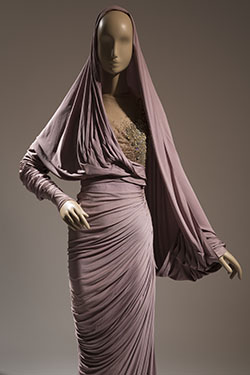
Adrian, costume, 1952, USA, from the film Lovely to Look At, 70.8.18
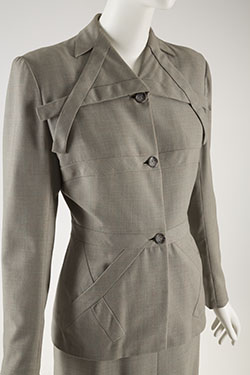
Adrian, suit jacket, circa 1950, USA, 73.66.1
From an examination of Adrian’s construction techniques and applications of textiles,
a clear picture of the designer emerges — as both artist and engineer. As Eleanor
Lambert, fashion publicist and founder of New York Fashion Week, wrote in a review
of Adrian’s spring 1952 collection, “The fabric is the first signal that the costume
is an Adrian.” His appreciation of textiles and their design potential set Adrian
apart in Hollywood and beyond.
Adrian: Hollywood and Beyond was organized by the graduate students in the Fashion Institute of Technology’s MA
program in Fashion and Textile Studies: History, Theory, Museum Practice, with the
support of Sarah Byrd, Ariele Elia, and Emma McClendon.


